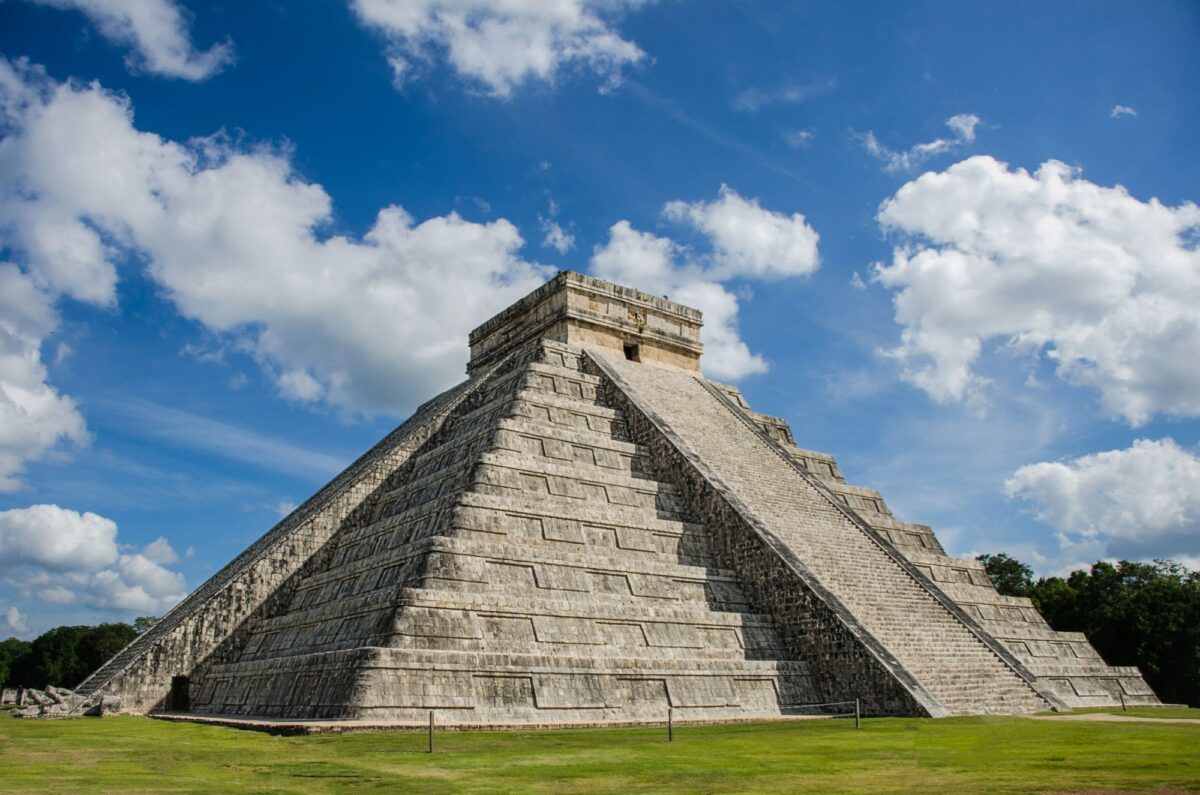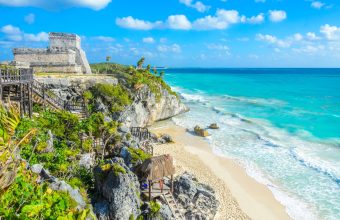Visiting Chichén Itzá
How to get to Mexico's most famous Maya ruin
One of the New Seven Wonders of the World, this Maya city was at its height in the 10th century, when it commanded a vast area of what is now the Yucatan Peninsula.
Chichén Itzá’s ceremonial, cultural and administrative centre sprawls out over 2.5 square miles, its edifices aligned with celestial bodies. Within this same area, there were sacred sinkholes (cenotes), where sacrifices to the rain god Chaac were made to ensure that life-giving water was always abundant.
A city built in stages from around 600 CE, it was finally abandoned around 1250 CE, but so mighty was its power, and so sacred the sinkholes, that Chichén Itzá continued to be a site of pilgrimage for the Maya for hundreds of years beyond.
Today, a different type of pilgrimage occurs, with almost 1.5 million visitors flocking to the site each year. The excavated structures and the pristine nature of this archaeological site have been part of the allure, as well as its proximity to tourist hubs like Cancun and Playa del Carmen. The stories that the city holds, and the displays of Maya astrological and architectural prowess make it a noteworthy stop.
Yes, it is busy, but it is worth braving the crowds to explore this ancient Maya city and learn more about the history, beliefs and enduring cosmology of the people who lived there.

The Temple of Kukulkán (El Castillo, the Castle), Chichén Itzá's most recognisable building
How to get to Chichén Itzá
Chichén Itzá is well connected to the nearby cities of Merida or Valladolid, as well as to the tourist centres of Cancun and Playa del Carmen.
Most international tourists get here on a day tour from the coastal resorts. Chichen Itzá is 200 km (2.5-hour drive) from Cancun, and 185 km from Playa del Carmen.
Tours cost around $70/£50 per person and typically include a buffet lunch and a trip to the nearby Ik Kil cenote (sinkhole).
It’s relatively easy to visit independently, either by public bus or in a rental car but to truly bring the site to life and learn about Maya history and culture, hiring a guide or joining a guided tour is highly recommended. Chichén Itzá is so rich with history that archaeologists continue to make new discoveries and a good guide will be able to give you up-to-date findings that have yet to reach your guidebooks.
How much time do you need for Chichén Itza?
Most tour groups spend about 2.5 hours at Chichén Itzá. This is a good amount of time to see the most important structures at the site, however, depending on the intensity of the sun, archeological buffs could easily spend the entire day there exploring in greater detail. For most people it is worth allotting around three hours.
Do you need tickets for Chichén Itzá?
Yes. You can buy tickets in advance to avoid the queues but tickets are also available at the entrance. Always bring cash, in case the credit card machines are not working.
How much does it cost to enter Chichén Itzá?
At time of publication (and taking in varying exchange rates) the cost of a ticket was $481 Mexican pesos ($24/£17), 75 pesos of which goes to the National Institute of History and Archeology (INAH) to help with further research and excavation.
Can you go to Chichén Itzá without a tour?
Yes. You can arrive by bus or rental car from and enter without a tour or a guide. Using the signage and guide books, you can have an interesting and enjoyable visit. If you do decide you want a guide (and great guides can really make the place come to life), there will be many around the entrance, offering their services for around $600 pesos ($30/£20). If you have a particular interest, ask them about it before hiring them, to see if they are the right guide for you.
Car rental is economical (starting at around $15/£10 per day), the roads are well maintained and enjoyable to drive and the signage is generally good. Pro tip: Arriving at Chichén Itzá, you may want to pay the extra few pesos to park in the shaded area of the car park, so you have a more comfortable ride back.
How to get to Chichén Itzá by bus
The bus to Chichén Itzá leaves Cancun’s First Class ADO bus station at 8.45am and departs Chichén Itzá to return to Cancun at 4.30pm. The journey takes roughly three hours. If you miss the 8.45am bus you can also travel from Cancun to Valladolid where there are more departures to Chichen Itzá throughout the day.
What to see at Chichén Itzá
Temple of Kukulkán (‘El Castillo’)
The most iconic structure at Chichén Itzá is the Temple of Kukulkán, more commonly referred to as El Castillo, or the Castle. This is a four-sided pyramid that stands 98ft high, dedicated to a feathered serpent god called Kukulkán, similar to the Aztec god, Quetzalóatl. In total the pyramid has 365 steps—91 on each of its four sides, plus the top platform—making one step for every day of the year. The carved heads of open-mouthed serpents lie at the bottom of each of the stairways.
Created at the height of the city’s power and presided over by priests who performed magic as well as human sacrifice at the temple, Kukulkán is mathematically, astrologically and aesthetically impressive, and is one of the most well-photographed Maya temples. The structure is built above a cenote, and in 2018 excavations began to unblock a secret tunnel closed by the Maya many hundreds of years ago, which leads to the water and the Maya underworld. Other excavations have revealed earlier structures within the temple and a bright red jaguar throne with eyes of jade was among the objects discovered inside.
Equinox
To understand even further just how masterly Maya astrological knowledge and construction skills were, you will want to visit Chichén Itzá during either the spring or autumn equinox.
Due to perfect alignment with the sun, a shadowy figure of a snake descends the northern steps of the Temple of Kukulkán in the late afternoon sun of each equinox. The Maya believed that the serpent then entered the cenote.
The alignment of the shadow is exact for a few days before and after the equinox, so visit on the days surrounding the equinox, rather than on the equinox itself, to enjoy the spectacle with less visitors.. If you feel like joining in, you might want to wear white, which some believe attracts positive energy from the new sun.
Ballcourt
The ballcourt at Chichén Itzá, where ancient Mesoamerican ball games were played, is one of the largest known courts in the Americas at 225 ft wide and 545 ft long. Engravings along the sides of the court depict warrior ball game players and the court is another perfectly constructed edifice, with precision planned acoustics. Stand in the middle facing the walls, clap and you will hear it echo precisely seven times. There are also raised platforms at each end of the ballcourt and a whisper is said to be able to travel from one end to the other, although this can be harder to test when the site is full of visitors.
The ballgame was an intense sport. A 3-4 kg ball, made from the rubber of local trees, was smacked from each side of the court using the players hips, elbows and knees. The ball was not allowed to hit the floor.
There is some debate about whether winners of losers were sacrificed at the end of the game, with many archeologists suggesting it was likely the captain of the winning team who was decapitated. Such honour would see him go straight to the highest tier of ‘heaven’.
Skull Platform
Another edifice of note is the Skull Platform, a rectangular structure, which is carved with images of skulls, hence its name. The real craniums of sacrificial victims would once have been displayed upon the flat top of the platform, threaded one above the other onto wooden poles to provoke fear in rival groups.
The Temple of the Warriors
The Temple of the Warriors also deserves a visit. This large temple flanked by pillars with carvings of elaborate warrior figures was built in an architectural style which resembles that of the Toltec people of central Mexico. As you approach, look up to see the carving of Chac Mool, the reclining male figure waiting for sacrificial offerings to be placed in the bowl on his stomach.
Sacred Cenote
The whole of the Yucatan is pockmarked with sinkholes due to a crater—widely believed to have led to the distinction of the dinosaurs—which hit the earth there some 66 million years ago. These sinkholes, known as cenotes, were believed by the ancient Maya to be the connection to the underworld. Offerings were regularly made here in honour of the God of Rain. Initially precious objects were thrown into the cenotes and later human sacrifices (particularly of children and young women) were made here. Those who were to be sacrificed are believed to have had their hands and feet tied and to have been loaded up with jewels so that they would sink quickly. In 1904, the first dredging of the cenote occurred, but sadly many of the precious objects retrieved were stolen. Later excavations revealed objects such as jade, obsidian and gold as well as human skeletons.
Venus Temple Platform
So called because of the bas reliefs of Venus on the sides, the Venus Temple Platform was likely used for ritual and ceremony. When it was rediscovered, a skull of a decapitated man was found on the eastern stairwell. As one of the closest structures to the cenote, some suggest that sacrificial victims would have been dressed there and led in procession to be drowned in the cenote.
Tips for visiting Chichén Itzá
Chichén Itzá is a large archaeological site with limited shade (although more trees are being planted to remedy that) so be sure to wear a hat and sunscreen and take plenty of water. The site is rocky and uneven, so it's best not to arrive wearing flip flops.
Arrive early (8am) to avoid the sun and the large tour buses that arrive at around 11am. When you arrive, head straight to El Castillo to get a shot of it while it is quiet. Later in the day, it is unlikely that you will be able to get a photo by yourself.
Where possible, it is best to avoid visiting Chichén Itzá on a Sunday, since Mexicans get free entry and the site is even busier.
Make sure you bring Mexican pesos to pay the entrance fee, as credit card machines often break down. For an even simpler option and to avoid the queues, consider buying your ticket online in advance.
The nearby Ik Kil cenote is a popular place to stop off after a visit to Chichén Itzá and it is very beautiful, easily accessible and a great option if your time is limited. It does get busy though, so if you have time to go further afield, head to the Xkeken and Samula cenotes which are about a 40-minute drive away in the direction of Valladolid.
If you have more time, consider staying the night at one of the hotels situated around the site. An overnight stay means that you can be the first to arrive at the site in the morning or the last to leave at night and you can spread your visit out over a couple of days, making the heat more bearable.






